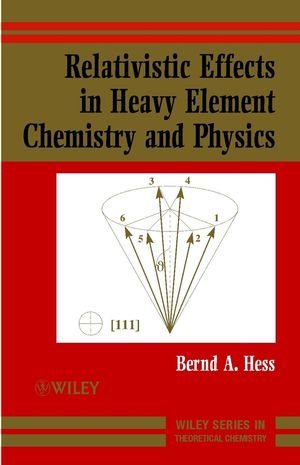Relativistic Effects in Heavy-Element Chemistry and PhysicsISBN: 978-0-470-84138-9
Hardcover
350 pages
November 2002
 |
||||||
List of Contributors.
Foreword.
Preface.
1. Basic Theory and Quantum Electrodynamics in StrongFields.
Introduction.
Electrons in Superintense Laser Fields.
Electron-Positron Pair Creation in Relativistic Heavy-IonCollisions.
Relativistic and QED Effects in Highly Charged Ions.
2. Four-Component Ab Initio Methods for Atoms, Moleculesand Solids.
Introduction.
General Many-Electron Formalism.
Atomic-Structure Calculations.
Molecular Structure Calculations.
Electronic Structure of Solids.
Concluding Remarks and Perspective.
3. Relativistic Quantum Chemistry with Pseudopotentials andTransformed Hamiltonians.
Introduction.
Transformed Hamiltonians: Theory.
Transformed Hamiltonians: Applications.
Valence-Only Effective Hamiltonians.
Effective Core Potentials: Applications.
4. Relativistic Density Functional Theory.
Introduction.
Foundations.
Implicit Density Functionals.
Explicit Density Functionals.
Norm-Conserving Pseudopotentials.
A pplications of RDFT using the Relativistic DiscreteVariational Method.
5. Magnetic Phenomena in Solids.
Introduction.
Formalism.
Applications.
6. Experimental and Theoretical Study of the Chemistry of theHeaviest Elements.
Introduction.
Theory.
Experiment.
Element 105.
Element 106.
Summary.
7. Experimental Probes for Relativistic Effects in the Chemistryof Heavy d and f Elements.
Introduction.
Gas-Phase Ion Chemistry of Heavy Elements.
Structural Chemistry of Gold Compounds in the CondensedPhase.
Conclusions.
Appendix A.
References.
Index.
Foreword.
Preface.
1. Basic Theory and Quantum Electrodynamics in StrongFields.
Introduction.
Electrons in Superintense Laser Fields.
Electron-Positron Pair Creation in Relativistic Heavy-IonCollisions.
Relativistic and QED Effects in Highly Charged Ions.
2. Four-Component Ab Initio Methods for Atoms, Moleculesand Solids.
Introduction.
General Many-Electron Formalism.
Atomic-Structure Calculations.
Molecular Structure Calculations.
Electronic Structure of Solids.
Concluding Remarks and Perspective.
3. Relativistic Quantum Chemistry with Pseudopotentials andTransformed Hamiltonians.
Introduction.
Transformed Hamiltonians: Theory.
Transformed Hamiltonians: Applications.
Valence-Only Effective Hamiltonians.
Effective Core Potentials: Applications.
4. Relativistic Density Functional Theory.
Introduction.
Foundations.
Implicit Density Functionals.
Explicit Density Functionals.
Norm-Conserving Pseudopotentials.
A pplications of RDFT using the Relativistic DiscreteVariational Method.
5. Magnetic Phenomena in Solids.
Introduction.
Formalism.
Applications.
6. Experimental and Theoretical Study of the Chemistry of theHeaviest Elements.
Introduction.
Theory.
Experiment.
Element 105.
Element 106.
Summary.
7. Experimental Probes for Relativistic Effects in the Chemistryof Heavy d and f Elements.
Introduction.
Gas-Phase Ion Chemistry of Heavy Elements.
Structural Chemistry of Gold Compounds in the CondensedPhase.
Conclusions.
Appendix A.
References.
Index.



